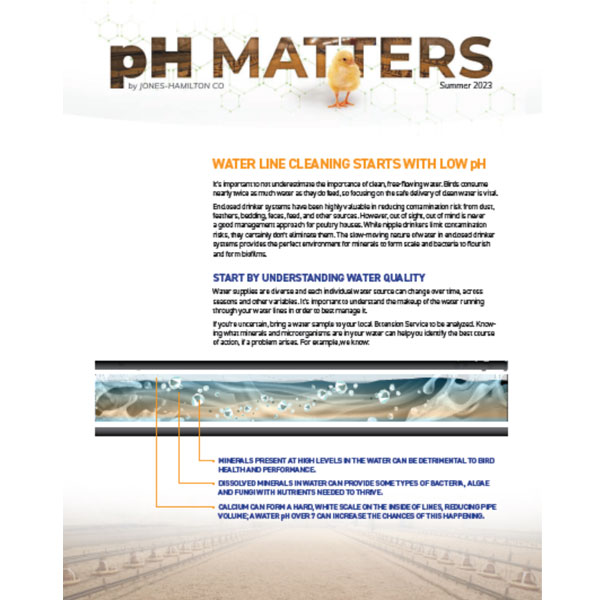Poultry Water Line Cleaning Starts with Low pH
When did you last think about poultry water line cleaning? It’s important to not underestimate the importance of clean, free-flowing water. Birds consume nearly twice as much water as they do feed, so focusing on the safe delivery of clean water is vital.
Enclosed drinker systems have been highly valuable in reducing contamination risk from dust, feathers, bedding, feces, feed, and other sources. However, out of sight, out of mind is never a good management approach for poultry houses. While nipple drinkers limit contamination risks, they certainly don’t eliminate them. The slow-moving nature of water in enclosed drinker systems provides the perfect environment for minerals to form scale and bacteria to flourish and form biofilms.
START BY UNDERSTANDING WATER QUALITY
Water supplies are diverse and each individual water source can change over time, across seasons and other variables. It’s important to understand the makeup of the water running through your water lines in order to best manage it. If you’re uncertain, bring a water sample to your local Extension Service to be analyzed. Knowing
what minerals and microorganisms are in your water can help you identify the best course of action, if a problem arises. For example, we know:

- MINERALS PRESENT AT HIGH LEVELS IN THE WATER CAN BE DETRIMENTAL TO BIRD HEALTH AND PERFORMANCE.
- DISSOLVED MINERALS IN WATER CAN PROVIDE SOME TYPES OF BACTERIA, ALGAE AND FUNGI WITH NUTRIENTS NEEDED TO THRIVE.
- CALCIUM CAN FORM A HARD, WHITE SCALE ON THE INSIDE OF LINES, REDUCING PIPE VOLUME; A WATER pH OVER 7 CAN INCREASE THE CHANCES OF THIS HAPPENING.
THE IMPACT OF ADDITIVES
While water-based additives can provide nutrients and enhance vaccines, they can also promote the growth of biofilm in water lines at the same time. Powdered drink mixes, vitamins, electrolytes, and others are great food sources for biofilm.
At the same time, the presence of biofilm can decrease the effectiveness of certain medications, such as antibiotics, and create challenges that could reduce feed conversion and increase condemnations. For example, bacteria in biofilm have been shown to exhibit a 10 to 1,000-fold increase in antibiotic resistance compared to similar bacteria freely floating in solution.
FLUSH WATER LINES TO ENHANCE WATER QUALITY
Routine flushing is probably the simplest approach to poultry water line cleaning. It is recommended to flush lines thoroughly after the delivery of any additive, keeping in mind the following guidelines:

FLUSH ONE MINUTE FOR EVERY 100 FEET OF WATER LINE

BETWEEN FLOCKS, USE CLEANING AND SANITIZING PRODUCTS TO REMOVE ANY SCALE BUILDUP MORE EFFECTIVELY

TRIGGER ALL THE NIPPLES AND LET THE CLEANING/SANITIZING PRODUCTS TO SIT BEFORE FLUSHING AGAIN. BE SURE TO FLUSH LONG ENOUGH TO COMPLETELY PURGE THE LINES.
MANIPULATE pH TO MAXIMIZE POULTRY WATER LINE CLEANING
PWT pH water treatment can be used to manipulate pH in order to maximize chlorine effectiveness for water line cleaning and sanitation. As the strongest food grade mineral acid
available, PWT requires a low addition rate to acidify drinking water to biologically effective low levels.
When used to clean water lines between flocks, PWT helps dissolve lime and scale to restore and maintain full function of lines for optimum flow. To maximize effectiveness of PWT and keep water lines clean, keep these tips in mind:
- The first time you use PWT in a house for cleaning, it should only be left in the lines about 8 hours due to the large amounts of debris that is removed during the cleaning process. This will facilitate the removal of this gelatinous material from the drinker system.
- After PWT has been used to clean the drinker system, then it can be left in the lines as long as 24 hours prior to flushing.
- Run PWT through lines at the end of every flock and after running any type of water additive such as electrolytes or vitamins to help remove any residual material that acts as
a good source of food for bacteria.
And remember; PWT is a food grade acidifier that is GRAS and is on the EPA Safer Choice list of chemicals, so you can be confident it is safe for birds, people, and the environment. Want to know more about PWT pH water treatment? Contact the professionals at Jones-Hamilton Co. today.

